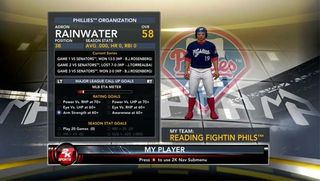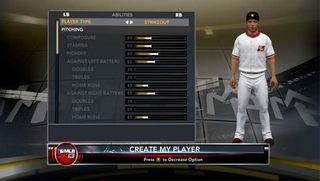MLB 2K13 my player guide
Career Guide

It’s every baseball fan’s dream to play for a Major League team one day, and with the help of games like MLB 2K13 those dreams can become a reality. We’ve put together a primer for this year’s My Player mode to give you a head start on becoming the next big phenom. Forget Mike Trout and Bryce Harper; your player is going to outshine them all.

PLAYER CREATION
MLB 2K13’s My Player mode isn’t as intricate as the career mode found in the NBA 2K series, but that doesn’t mean there aren’t a lot of different ways you can play. Though there are nine positions on the field, My Player basically breaks down into fielders and pitchers. Both career paths feature nine different player archetypes, with each having distinct advantages and disadvantages. The archetype you choose will have a tremendous influence on how easy (or challenging) it is for you to progress through the Minors and into the MLB.
As a fielder, you’ll also have the advantage during creation to choose a secondary position. Make sure it’s a position your created persona will be able to play easily (second base and shortstop, catcher and first base, third base and outfield) as MLB 2K13 will automatically place you into this second position in the Majors if a higher-rated player is holding your primary spot. Even if the player at the second position is rated higher than your created one, you will get the starting nod.
It should also be noted the youngest you’ll be able to make your player is 19. That means no birthdates later than 1994. It’s not really that big a deal, as you’re only missing out on one more possible year of eligibility. However, when you finish creating your player and picking your team, you jump ahead to June 2013 in the schedule. You lose some valuable playing months as MLB 2K13 won’t let you in the league until after the Amateur Player Draft.

FIELDER ROLES
As we said before, there are nine different base stat groups for both fielders and pitchers. Once you’ve gone ahead and gotten the look of your player down, you’ll have to choose from one of these nine archetypes. You cannot change the value of any of these attributes at all until you start earning experience as a professional player. There is no custom class.
All Around: All of the stats are rated nearly evenly, which makes this role ideal for newcomers.
Contact: Great at getting the bat on the ball, but average to below average everywhere else.
Lead Off: The best acceleration out of the bunch, but offers little in every other attribute category.
Speedster: Fast, and that’s about it. Weak arm, weak bat.
Slugger: Low contact, but plenty of pop. Fairly slow, but fielding stats are average.
Utility: Below average in almost all categories. Under no circumstances should you ever pick this role.
Gold Glover: Top-notch fielder, but capable of little else on the diamond.
Clutch: High clutch rating, and that’s about it.
Team Leader: Virtually indistinguishable from the All Around.
The All Around really is one of the better roles to base your player on, with the Slugger and Contact roles falling in close behind. You can get by on fielding just fine without the Gold Glover role, and stats categories like Clutch and Utility have no real purpose for those you planning to play every single at-bat.

PITCHER ROLES
The pitcher roles are a little bit different, and thus offer slightly more customizability than the fielder roles. Even though the pitcher has a bit more to work with in regards to strengths and weaknesses between roles, there are also only a handful of the nine available that we would recommend using. It should also be noted, the categories here will impact your individual pitches as well.
All Around: Average attributes in all categories. Will result in rudimentary control, velocity for pitches.
Strike Out: Better at preventing contact by right- and left-handed batters, but lower stamina. High velocity and decent movement for pitches.
Ground Ball: Slightly better at preventing homeruns. Average pitch statistics.
Fly Ball: Has decent pick-off, but fairly below average in other attributes. Average pitch statistics.
Work Horse: High stamina, and solidly average in most every major pitching attribute. Average pitches.
Finisher: Low stamina and high composer. Good for those who wish to be closers. High velocity and decent movement for pitches.
Clutch: Has a good clutch rating, but offers little else. Average pitches.
Control: Similar to the All Around, though you will have better starting control over your pitches than you will velocity or movement.
Team Leader: Again, virtually indistinguishable from the All Around.
As a pitcher, you’ll have to choose three pitches to start your career. The first pitch must always be a fastball of some sort (cutter, four-seam, two-seam, etc.). The second and third pitches also have some strange caveats, but are have a little more freedom. Certain pitches like the slider can’t be picked for your third pitch, but can be for your second. There’s no real rhyme or reason why. As you pick different pitches, you’ll notice the Tendency category changes for all three pitches every time you change one selection. The Speed, Control, and Movement are all based off of your player role, so they won’t budge an inch. You can adjust the Tendency after you find the three pitches you want to keep, but its affect on the overall game is very minimal.
Sign up to the 12DOVE Newsletter
Weekly digests, tales from the communities you love, and more
